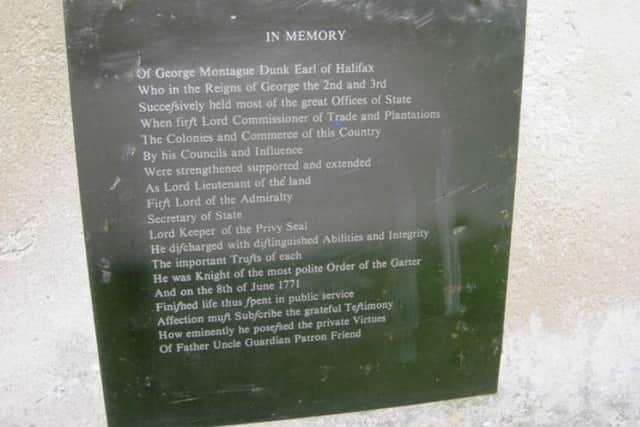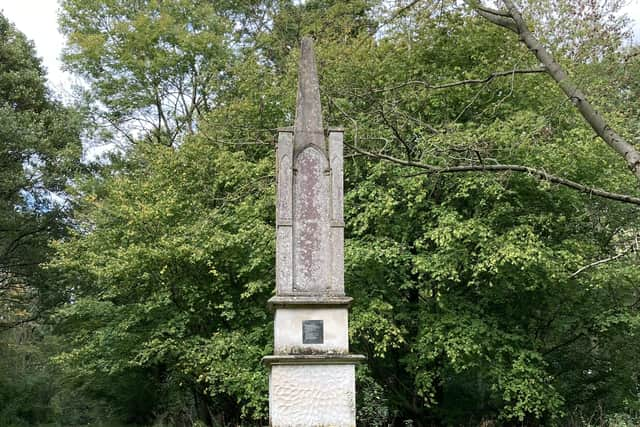‘Chicksands Wood monument must go due to slavery links’ argues campaigner
and live on Freeview channel 276
Holly McGivern, 42, from North Herts, visited the area for a scenic walk during July and came across the monument, which is dedicated to George Montagu-Dunk, the second Earl of Halifax.
On October 5, she contacted both the Forestry Commission, who own the land, and Central Bedfordshire Council, to ask that the obelisk be removed.
Advertisement
Advertisement
During the reign of George II, Montagu-Dunk was appointed as first Lord of Trade and Plantations, becoming known as the “Father of the Colonies”, whilst as president of the Board of Trade, he helped to found Halifax, Nova Scotia.


Commenting on the obelisk, Holly said: “It represents a lie and it is offensive to people who didn’t benefit from that lie.
“The lie is that Britain had this ‘great empire’ and that everything was fantastic; in reality, millions of people died and thousands were born into violence.
“It should ultimately be removed or placed in a museum with an honest explanation [about the ramifications of Montagu-Dunk’s actions].
Advertisement
Advertisement
“We’re not eradicating history, but we need to show that we are moving beyond revering these people.


“Just because the obelisk has been there for hundreds of years doesn’t necessarily mean it’s acceptable or right. We should learn from history. You can’t whitewash it.”
In the west aisle of the north transept of Westminster Abbey, there is a memorial to Montagu-Dunk, on which an inscription states: “He was soon after appointed first Lord of Trade and Plantations; in which department he contributed so largely to the commerce and splendour of America, as to be styled ‘Father of the Colonies’.”
Meanwhile, The British Museum states that Montagu-Dunk was: “much involved in colonial development and north American trade”.
Advertisement
Advertisement
However, Holly told the Chronicle: “His aggressive approach to centralising and controlling the colonies of Britain led to countless deaths.
“The city namesake of the second Earl of Halifax in Nova Scotia, Canada, is given due to him colonising this area; he brokered this arrangement in direct contravention of a previous treaty with the First Nation Mi’Kmaq, stealing their land and no doubt enabling starvation, slaughter and forced movement of these people as a result.
“He was complicit in and benefitted from slavery, as a member of SPG (the Society for the Propagation of the Gospel in Foreign Parts) owned plantations in Barbados, and personally took credit for the forced religious conversion of African slaves in Barbados to prevent uprisings.
“Baptising slaves was part of the second Earl of Halifax’s mission to ‘enlighten’ Africans of the ‘merits’ of slavery. The SPG was a keen opposer of any mass manumission.”
Advertisement
Advertisement
Holly also claimed: “His ‘pacification’ of the Jacobean uprising in 1745 directly resulted in a huge spate of anti-Catholic violence in England.”
Holly emailed the Forestry Commission and Central Bedfordshire Council on Monday, October 5, to ask that the obelisk be removed. However, before the story went to press, she informed the Chronicle that she had not heard back from either.
Holly added: “I understand that as part of Central Bedfordshire’s Equality strategy and Outdoor Access Improvement Plan it aims to support and enable safe, attractive and inclusive communities.
“A monument to someone who’s lifetime career was spent directly putting the lives of people in danger through the slave trade, exclusive of any freedom of religious thought, is a direct contravention of these goals.
Advertisement
Advertisement
“One thing that really struck me when I saw the obelisk first was the brutal irony that when our colonial rule diminished and slavery ended, the reparations were paid to slave traders and owners rather than the millions of slaves that suffered under colonial rule, amounts equating to billions of pounds in today’s terms. This is another of the many crucial elements of our Imperialist past that is excluded from our national education and blinkered narrative of empire.
“Monuments like this applaud these men and a system which traded in human flesh and violently displaced entire communities from land they had lived on for generations.”
A Forestry England spokesman said: “Forestry England manage public land and the secretary of state for digital, culture, media and sport recently set out the government’s position on contested heritage in that it does not support the removal of statues or other similar objects.
“He also said that DCMS are developing a more complete understanding of the ongoing work connected to contested heritage.”
Advertisement
Advertisement
A CBC spokesman said: “CBC is wholly committed to reflecting the communities we serve and doing all we can to ensure we continue to confront racism and inequality.
“However, the monument has been placed on land that belongs to the Forestry Commission and, as such, it is a matter which needs to be addressed directly with the commission.
“We would encourage the Forestry Commission to consider the suitability of the monument.”
Referencing the toppling of Edward Colston’s statue in response to the Black Lives Matter movement, Holly added: “Men like Colston and Montagu-Dunk are not individual ‘villains’, rather they were part of institutional systems of power and racism. I don’t think Montagu-Dunk had a direct intention to displace, murder and starve the Native American population, but he was, however, directly involved in colonisation.”
> Do you agree with Holly or not? Email [email protected]